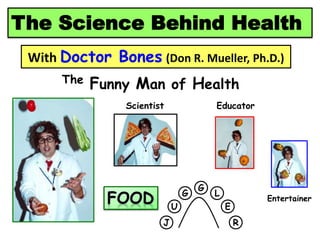
An Examination of Carbohydrates in the Diet.
- 1. The Science Behind Health With Doctor Bones (Don R. Mueller, Ph.D.) The Funny Man of Health Educator Entertainer J U G G L E R Scientist
- 2. Carbohydrates (Sugars) Carbohydrates contain carbon (C), hydrogen (H), and oxygen (O). They are more familiar to us as a variety of sugars, starch and cellulose (fiber). Sugars are the simplest carbohydrates. Starch and cellulose are called complex carbohydrates, but they are really just long chains of simple carbohydrates (sugars). French scientists in the early days of sugar chemistry, used the term 'hydrate de carbone‘ for carbohydrate.
- 3. The name "carbohydrate" was originally chosen because it was first thought that carbohydrates were hydrated (water) carbon compounds based on their empirical formula Cn(H2O)n. However, if we examine the molecular structure of glucose, we find that it isn't H2O that is bonded directly to carbon, but instead it is OH and H. Glucose (C6H12O6) Via photosynthesis, plants use carbon dioxide (CO2), water (H2O) and sunlight to construct carbohydrates such as glucose (C6H12O6) as the following chemical reaction illustrates: 6 CO2 + 6 H2O C6H12O6 + 6 O2
- 4. Simple Sugars (Monosaccharides) Glucose, Galactose and Fructose are all simple sugars. They are also called monosaccharides because they have only one sugar unit. Although the three sugars have the same molecular formula (C6H12O6) they differ in molecular structure (positions of the individual atoms). All three sugars are known as "hexoses" as they all have six carbon atoms.
- 5. Sucrose, more commonly known as Table Sugar, is a disaccharide because it has two sugar units: a Glucose ring and a Fructose ring. Sugars made from 2 or 3 sugar units are called oligosaccharides. Lactose (milk sugar) is yet another example of a disaccharide. It is made from one glucose molecule and one galactose molecule. Disaccharides: two sugar units joined by a glycosidic bond.
- 6. The 3-D molecular structures of several sugars are shown in the next two frames. The black-colored spheres are carbon atoms, the red ones are oxygen and the smaller white-colored spheres represent hydrogen atoms. Lactose Glucose
- 8. In 1747, the German pharmacist Andreas Marggraf, extracted glucose from grapes and sucrose from beets. In 1838, the French chemist Jean Baptiste Andre Dumas, coined the name glucose from the Greek word "glycos," meaning sugar or sweet. The molecular structures of glucose, fructose, galactose and mannose were determined by the German chemist Emil Fischer, the “Father of carbohydrate chemistry."
- 9. Complex Carbohydrates (Starch and Cellulose) Starch and cellulose are both polymers of glucose. Scientists call them polysaccharides (many glucose units), whereas the general public simply refers to them as, "complex carbohydrates." There are two basic types of starch molecules: amylose (linear, unbranched chains of hundreds of glucose units) and amylopectin, which differs from amylose as it is highly branched. Amylose
- 10. Potatoes are rich in starch. Grains such as wheat, rice and corn are also good sources of starch as are beans, legumes and various fruits and vegetables. Why did the potato cross the road? Because he saw the fork up ahead.
- 11. Cellulose is a linear polysaccharide and is the major component in the cell walls of plants. Wood is constructed largely of cellulose. Both cotton and paper are nearly pure cellulose. Humans are unable to digest cellulose because we lack the necessary enzymes to break its sugar linkages. As a consequence, cellulose serves solely as fiber in our diet.
- 12. Glycogen – the intermediate “energy storage” molecule Humans and animals can store excess glucose in a molecular form called glycogen, which is stored predominantly in the liver and the skeletal muscles. Muscle and liver glycogen stores can be used up in less than a day when carbohydrates are not being consumed. The following frame illustrates a glycogen molecule. The numbers given in red specify the positions of the carbon atoms in the glucose molecule, which contains 6 carbon atoms. The figure also illustrates the two different ways in which the glucose rings are linked together in glycogen. Linkages are designated, 1-4 and 1-6, meaning that carbon atom 1 in one glucose ring is connected either to carbon atom 4 or carbon atom 6 in the other glucose ring, respectively.
- 13. Glycogen It should be noted that the 1-4 linkages are found in the straight chains and the 1-6 linkages, form the branches in glycogen, which is a highly-branched molecule.
- 14. Diets Rich in Complex Carbohydrates: If necessary, glucose can be made from protein. This is a process known as gluconeogenesis, which utilizes non-carbohydrate sources to synthesize glucose. However, unless you are eating a diet rich in protein, this generally means breaking down muscle protein. In other words, you will be sacrificing your muscle tissue for energy in the form of glucose. Because the human brain runs on glucose, it needs a steady supply throughout the day. Your best bet is to eat a diet rich in complex carbohydrates. There are many foods to choose from. Enjoy!
- 15. Mr. Whole Grains says, "Try Whole Grain products for better nutrition."
- 16. Whole-grain breads, cereals and pasta are more nutritious than their refined grain counterparts. Whole-grain brown rice, oats, wheat and corn are more nutrient dense and have much more fiber than those grains that have been refined by milling. Whole grains have three basic parts: (1) Bran, (2) Endosperm, and (3) Germ. The refining (milling) process largely strips whole grains of the bran and germ, stripping away nearly all of the fiber and much of the nutrients. The refined grain products must then be fortified with vitamins and minerals. Go whole grain! 1 2 3
